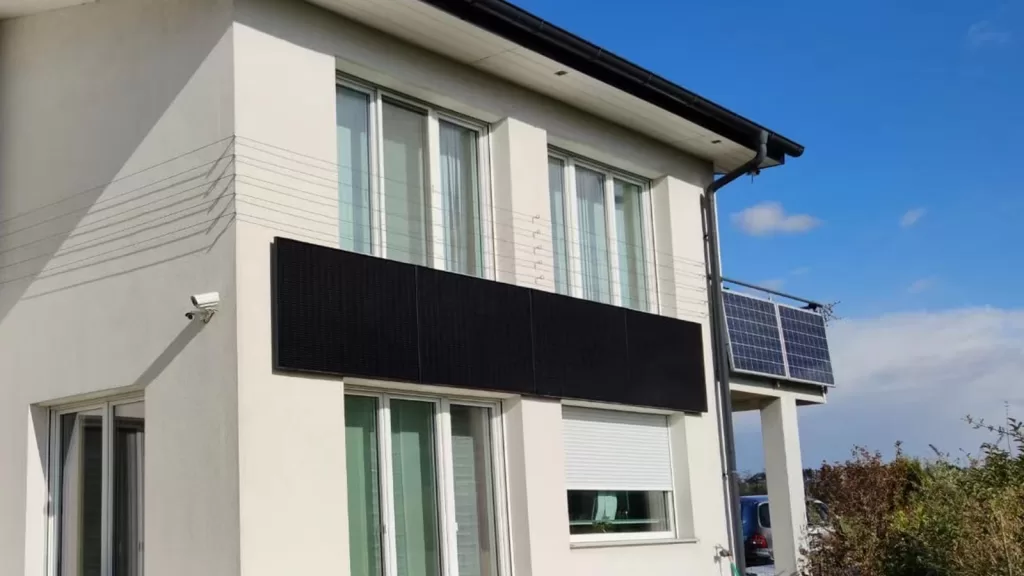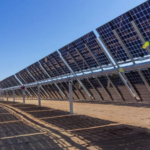Table of Contents
What Are Vertical Solar Panels?
Vertical solar panels are photovoltaic solar installations mounted on vertical surfaces, contrasting with traditional panels that are inclined on rooftops. This design is particularly suitable for densely populated urban areas with limited rooftop space or unfavorable installation conditions, as well as mountainous regions where snow may cover roofs. Vertical panels can better utilize the wall space of buildings, integrating solar energy into modern architecture while enhancing aesthetic harmony and providing more renewable energy options across different environments.
Although vertical solar panels utilize the same technology as conventional photovoltaic modules, their 90° installation angle offers greater flexibility in complex or confined spaces. They provide solutions for buildings where rooftop photovoltaic systems cannot be installed due to directional or slope limitations, making them easier to integrate into architectural designs and opening up new possibilities for the widespread adoption of sustainable energy.

Comparison of Vertical Solar Panels and Rooftop Panels
Pros:
Space Optimization
Vertical solar panels effectively utilize typically unused wall surfaces, making them ideal for buildings unsuitable for rooftop installations. They transform available vertical areas into energy production zones, particularly advantageous in densely populated urban settings, aiding buildings in effectively self-supplying green energy.
Strong Adaptability
Vertical solar panels are well-suited for use in complex environments, especially in urban areas or buildings with suboptimal rooftop structures. They can be flexibly installed on walls facing all four directions to maximize sunlight exposure, offering a level of versatility that traditional solar panels cannot achieve.
Durability and Ease of Maintenance
Due to their 90° installation angle, vertical panels are less prone to accumulating dust, leaves, and dirt, reducing the frequency of routine maintenance. Additionally, vertical installation helps avoid common waterproofing issues found on rooftops, extending system lifespan and lowering maintenance costs.
Seasonal Optimization
Vertical solar panels excel in winter when the sun’s angle is lower, providing higher energy output. Their production is more balanced throughout the year, aligning with peak electricity demand periods (such as early mornings and evenings), thus preventing grid overload.
Cons
Lower Efficiency
The light-capturing efficiency of vertical solar panels is lower than that of traditionally roof-mounted panels, generating only about 70% of the energy output of the latter over the course of a year. This is primarily due to the panels’ orientation and tilt, which limit their effective use of direct sunlight.
Higher Installation Costs
The complexity of vertical installation increases initial installation costs. The need for specialized equipment and skilled professionals raises installation expenses compared to traditional rooftop systems.
Aesthetic and Planning Restrictions
The appearance of vertical panels may not harmonize with certain architectural styles, and they must comply with local urban planning regulations (PLU). Securing the necessary permits before installation is essential, which differs from the requirements for rooftop installations.
Thermal Management Issues
Vertical panels may experience overheating due to reduced air circulation on walls, negatively impacting their efficiency. High temperatures typically decrease photovoltaic module performance, necessitating special attention to this potential efficiency loss.
Return on Investment and Payback Period for Vertical Solar Panels
The payback period for vertical solar panels is generally longer than for traditional rooftop installations, typically around 8 to 10 years. In contrast, the average payback period for rooftop photovoltaic systems is about 5 to 6 years. This extended payback period is due to the slightly lower energy output of vertical panels, especially when installed in suboptimal orientations or locations with windows and doors that limit available space. However, vertical photovoltaic systems can still provide substantial energy production for buildings, particularly in densely populated urban areas or where rooftop space is limited.
While vertical solar panels may not match the output of panels installed at ideal angles (such as 35 degrees), they offer a more consistent energy yield throughout the year and can serve as a facade covering, reducing the cost of other building materials. This dual functionality can further shorten the payback period. By the time the panels reach a lifespan of 25 years, the system typically recoups its costs within 10 years, resulting in a favorable return on investment and making it a reliable choice for promoting the application of sustainable energy across various environments.
Frequently Asked Questions About Installing Vertical Solar Panels
Why Use Vertical Installation?
The design of vertical solar panels is particularly suited for densely populated urban areas with limited space or unfavorable rooftop conditions, as well as mountainous regions where snow accumulates in winter. In these settings, traditional rooftop installations may be constrained, while vertical installations can fully utilize building facades and other vertical surfaces, optimizing space and energy generation efficiency.
What Scenarios Are Suitable for Vertical Installation?
- Exterior walls of residential buildings, balconies, and surrounding walls
- Facades of office buildings and public structures
- Agricultural photovoltaic projects
- Garden fences or courtyard areas

Do You Need Planning Permission for Vertical Solar Panels?
Before installing vertical solar panels, it’s essential to consult your city’s regulations, especially if you reside in protected buildings or conservation areas, as specific planning permissions may be required.
Recommended Types of Solar Panels for Vertical Installation
Choosing the right solar panels is crucial for vertical installations. For wall-mounted installations, it’s advisable to use monofacial modules to avoid overheating issues. For example, the highly popular IBC modules of 2024 offer excellent low-light performance, making them ideal for vertical wall installations.
For garden fences or agricultural photovoltaic projects, bifacial solar panels are the best choice. They can capture light from both sides, increasing light coverage and enhancing energy output. Recommended panel types include TOPCon and HJT modules, both of which excel in bifacial generation, significantly improving efficiency, particularly for vertical applications.
Since 2008, Maysun Solar has been dedicated to producing high-quality photovoltaic modules. Our range of solar panels, including IBC, HJT, TOPCon panels, and balcony solar stations, are manufactured using advanced technology and offer excellent performance and guaranteed quality. Maysun Solar has successfully established offices and warehouses in many countries and built long-term partnerships with top installers! For the latest quotes on solar panels or any photovoltaic-related inquiries, please contact us. We are committed to serving you, and our products provide reliable assurance.

Empowering Factories with Solar Energy A Strategic Tool for Controlling Production Electricity Costs
Commercial and industrial solar is becoming a key solution for factories to reduce electricity costs and hedge against price fluctuations. This article systematically analyzes its deployment models, cost advantages, and sustainable value pathways.

How Businesses Can Offset Carbon Taxes with Solar Power
This article analyzes the latest carbon tax policies and photovoltaic deduction strategies, helping European businesses legally reduce taxes, increase profits through solar investment, and achieve a win-win situation for both economy and environment.

Forecast and Response: Seizing the Next Decade’s Growth Dividend in Europe’s Commercial and Industrial Photovoltaics Market
Maysun Solar analyzes the growth trends of commercial and industrial photovoltaics in Europe over the next ten years, from policies and ESG to technological innovation, helping companies seize the initiative in the energy transition.

How to Calculate Solar System ROI and Optimize Long-Term Returns?
Solar power is becoming a key solution for businesses to reduce costs and improve efficiency. Accurately calculating ROI and optimizing long-term returns are essential to maximizing investment value.

Will Agrivoltaics Affect Crop Growth?
Agrivoltaics combines solar energy and agriculture to reduce up to 700 tons of CO₂ per MW, improve water use, and boost crop growth for sustainable farming.

6.5 Billion Loss Hits Photovoltaics: Reshaping or Elimination?
In 2025, the photovoltaic market may see a turnaround as some companies take early action. A €6.5 billion loss is driving businesses to explore new growth areas like energy storage and hydrogen. Which giants will break through? Industry transformation is accelerating!


-150x150.png)
